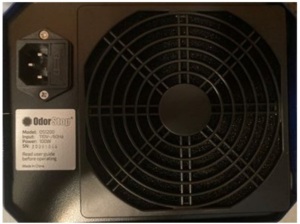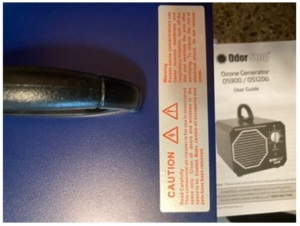
Press Release
Illegal Ozone Generators Sold in CA Can Harm Health, Settlement Shows Need for Stronger Enforcement
-
Focus Areas
Chronic Disease Prevention, Environmental Health -
Issues
Asthma -
Expertise
Outreach & Dissemination, Public Policy Advocacy, Research – Quantitative, Research – Surveillance -
Programs
Regional Asthma Management and Prevention Program

An undercover investigation led by the Public Health Institute’s Regional Asthma Management and Prevention (RAMP) program found that dangerous and illegal ozone generators are being sold to consumers in California, leading to settlements and fines designed to hold companies accountable and alert consumers of the dangers of these devices.
Ozone generator devices are marketed online for use in homes, daycare centers and other indoor environments for the removal of strong odors such as human or pet odors, smoke or mold. Although these devices are illegal under California law due to the dangers they pose, RAMP’s undercover investigation found that several companies illegally sold and shipped ozone generators to a personal residence in Oakland, California.
In a follow-up to the investigation, the California Air Resources Board (CARB) pursued enforcement action against the offending companies, and just announced a settlement with A2Z Ozone Inc. Unfortunately, the settlement totaled only $3,400, an amount that may not even cover a health insurance premium for one person experiencing asthma or chronic conditions as a result of breathing in indoor ozone over time. Two prior settlements have also taken place this year as a result of RAMP’s investigation:
- August 2023 OdorStop LLC $25,788
- April 2023 Alorair Solutions, Inc. $4,000

Ozone is highly toxic to the lungs and is particularly dangerous for young children and older adults. California works so hard to fight ozone smog in outdoor air. It’s shocking that companies are misleading consumers into buying devices to spew pollution in their homes,” explained Dr. Gina Solomon, principal investigator with the Public Health Institute and a partner on this project. “It’s important that companies be fined more for the health harms that they’re causing. A tiny fine isn’t a real deterrent.
Ozone generators are machines that create ozone gas and release it into the air. Since ozone is highly chemically reactive, it can react with odor molecules and change their composition. Ozone also damages the odor receptors in the nose, so people no longer perceive the odor. When inhaled, ozone can damage the lungs and even low amounts of ozone can cause chest pain, shortness of breath and irritation of the throat. Inhaling ozone can also worsen chronic respiratory conditions such as asthma and compromise a person’s ability to fight off respiratory infections.

People with asthma often benefit from an air cleaner to reduce their exposure to pollen, dust, air pollution or wildfire smoke. Ozone generators are marketed as if they are air cleaners even though they are the opposite. People don’t realize they are essentially creating toxic smog inside homes or buildings.Anne Kelsey Lamb
Director, RAMP, Public Health Institute
RAMP will continue their efforts to investigate companies in California who are illegally selling ozone generators to consumers, and to alert consumers to their risks. CARB also offers a list of potentially hazardous ozone generators that may be falsely marketed as air purifiers.
If you have information about ozone generators being sold or used in California, please reach out to RAMP by email at: info@rampasthma.org or email CARB at: aircleaners@arb.ca.gov to provide information for enforcement. Please also see the FAQ below on ozone generators.
About the Regional Asthma Management & Prevention (RAMP) Program
RAMP is dedicated to reducing the burden of asthma with a focus on health equity. Emphasizing both prevention and management, RAMP builds capacity, create linkages, and mobilize networks to advocate for policy and systems changes targeting the root causes of asthma disparities. For more information, please visit RAMP’s website.
Frequently Asked Questions
1. How are ozone generators different from air purifiers?
Ozone generators release ozone (the main component of “smog”) into the indoor air, which is dangerous to health. In fact, ozone generators are illegal for most uses in California. The best air purifiers (or air cleaners) use filtration to remove things from the air. For example, HEPA air cleaners filter out pollen, dust, mold, wildfire smoke, and other contaminants in indoor air. Some air cleaners release ions, “plasma” or UV light as a way of causing some particles to drop out of the air and stick to surfaces; these technologies may also be harmful to health and are not recommended.
2. How would I recognize an ozone generator?
Ozone generators look like a small rectangular box designed to sit on a table or other surface. They often have a handle on top, and openings along the front, like the pictures below.


3. What are ozone generators used for?
Ozone generators are marketed to remove odors from indoor spaces. Examples include the smell of cigarette smoke, pet smells, mildew, or fecal odors. They are also sometimes marketed to kill viruses, fungi or bacteria in indoor air.
4. Is ozone effective at eliminating odors? How does it work?
Ozone is very reactive with other molecules in the air and on surfaces. The theory is that ozone will react with chemicals that produce odors and eliminate them. Studies have found that ozone generators may temporarily reduce odors but are not effective long-term unless they are run continuously, which is dangerous for anyone who enters the indoor space.
5. Is ozone effective as a disinfectant? How does it work?
Ozone is effective at killing living things. For this reason, it can kill bacteria and viruses, but when it is in air at high enough levels to kill microbes, it is also dangerous to humans.
6. If people are trying to preserve the ozone layer, why is ozone bad?
Ozone is beneficial high in the upper atmosphere where it helps protect the planet from the damaging effects of sunlight. Ozone in the upper atmosphere is far from any location where people or animals breathe the air. Ozone at ground level is also known as “smog”, and it is well-known to damage plants, animals, and human health.
7. What does ozone do to harm people?
Ozone damages our lungs and respiratory system. It can cause shortness of breath, wheezing, and coughing. It also makes asthma and other lung conditions worse. Specific effects from ozone include:
- Decreased lung function and shortness of breath
- Asthma exacerbations
- Throat irritation and cough
- Inflammation of the airways
- Susceptibility to respiratory infections
- Chest pain
- Greater risk of hospitalization for respiratory conditions
This FAQ was developed by PHI’s Regional Asthma Management and Prevention (RAMP) program.
More Updates
Work With Us
You change the world. We do the rest. Explore fiscal sponsorship at PHI.
Support Us
Together, we can accelerate our response to public health’s most critical issues.
Find Employment
Begin your career at the Public Health Institute.



